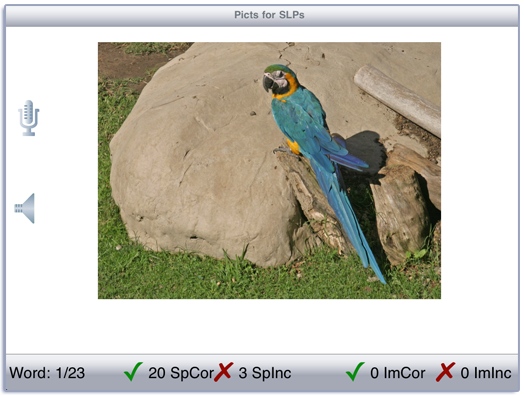
Pick pictures that match the interests of the child you are working with. There are 11 major categories like Plants, People, and Places. Within each category, there are sub-categories like Body Parts, Working, Playing, Airplanes, Trains, etc.
If you have a child who is fascinated by trains or planes, you can pick photos that will keep their interest. If you are working on expressive language skills, pick a category that they can relate to and ask the child to describe the actions in the picture. Can they imagine eating the food or petting the bunny?
You may change the text prompts to develop receptive and expressive language skills, articulation, word retrieval, pragmatics, voice, fluency, and more. If you have iOS7 or greater, the iDevice will speak the text for you.
Target Audience Appropriate for children and adults who need practice attending to complex auditory stimuli and respond verbally. This app encourages turn-taking, imitating, describing, questioning, answering, and playing with sounds and words. Learning these language concepts encourages verbal communication.
Just $4.99 on the App Store.
Information for Professionals
This app can be used to develop cueing strategies to facilitate word recall.
Expressive: Word Finding/ Anomia: Strategies
Hedge (1994) describes the following cueing hierarchies:
Modeling
What is this? It’s a…
Sentence Completion
“You write with a…”
Phonetic cues
“.... starts with a p....”
Syllabic cues
tap out syllables “ta-ble-cloth”
Silent Phonetic cues
Clinician begins to make the initial sound with articulators but without sound.
Functional description
“It is something you read...”
Description and demonstration of action
Client demonstrates the function of the item.
“I use it to write with. It’s a pen.”
Written cue
Client matches word to the item
Spelled cue
Client spells word, then says the word
Writing cue
Client writes the word, then says it
Presentation of a sound to evoke a name
“meow”
Repeated trials
Client evokes the correct response through drill.
Receptive/Expressive Language Strategies
Client will demonstrate comprehension of visually and auditorily presented stimuli by responding to computer prompt. Client will maintain attention during the auditory presentation of words and respond with words, phrases, or sentences as requested by teacher. Client will record speech and listen as speech is played back to learn self-monitoring skills. Client will rapidly name target stimuli when presented with visual prompts. Client will answer the question, “What is it?” with the sentence, “It’s a _____.” Client will label pictures using single word responses. Client will talk about pictures using two- to three-word phrases. Client will talk about pictures using full sentences. Client will correctly respond to “who”, “what”, “when”, “where”, “why”, “how”, “which”, “does”, “can”, and “do” questions. Client will ask “who”, “what”, “when”, “where”, “why”, “how”, “which”, “does”, “can”, and “do” questions.
Receptive/Expressive Language: Computer-assisted Strategies
Student will demonstrate comprehension of visually and auditorily presented stimuli by responding to computer prompt. Student will maintain attention during the auditory presentation of words and respond with words, phrases, or sentences as requested by instructor. Student will record speech and listen as speech is played back to learn self-monitoring skills. Student will acquire vocabulary for colors, numbers, and shapes. Student will form associations between colors, numbers, shapes, and the written text for each. Student will rapidly name target stimuli when presented with visual prompts. For example: Student will answer the question, “What is it?” for 10 shapes. Student will answer the question, “What color is it?” for 10 colors. Student will answer the question, “What number is it?” for 100 numbers.
Listening and reading Comprehension - Cloze procedure - Using the context Strategies
Client will use the Cloze procedure for assisting with spoken language expression and listening/reading comprehension. In order to successfully complete the sentences the client must relate the whole to the part and the part to the whole. This requires judgment and insight into the interrelationship of ideas. Moreover, the client's attention is directed to language patterns, word form, precise word usage, and grammatical correctness. This task is easily generalized to word finding in conversational speech when choosing the right word is important for communication.
Rationale This task requires the ability to attend to complex auditory stimuli and respond verbally. This app encourages turn-taking, imitating, describing, questioning, answering, and playing with sounds and words. Learning these language concepts encourages verbal communication.